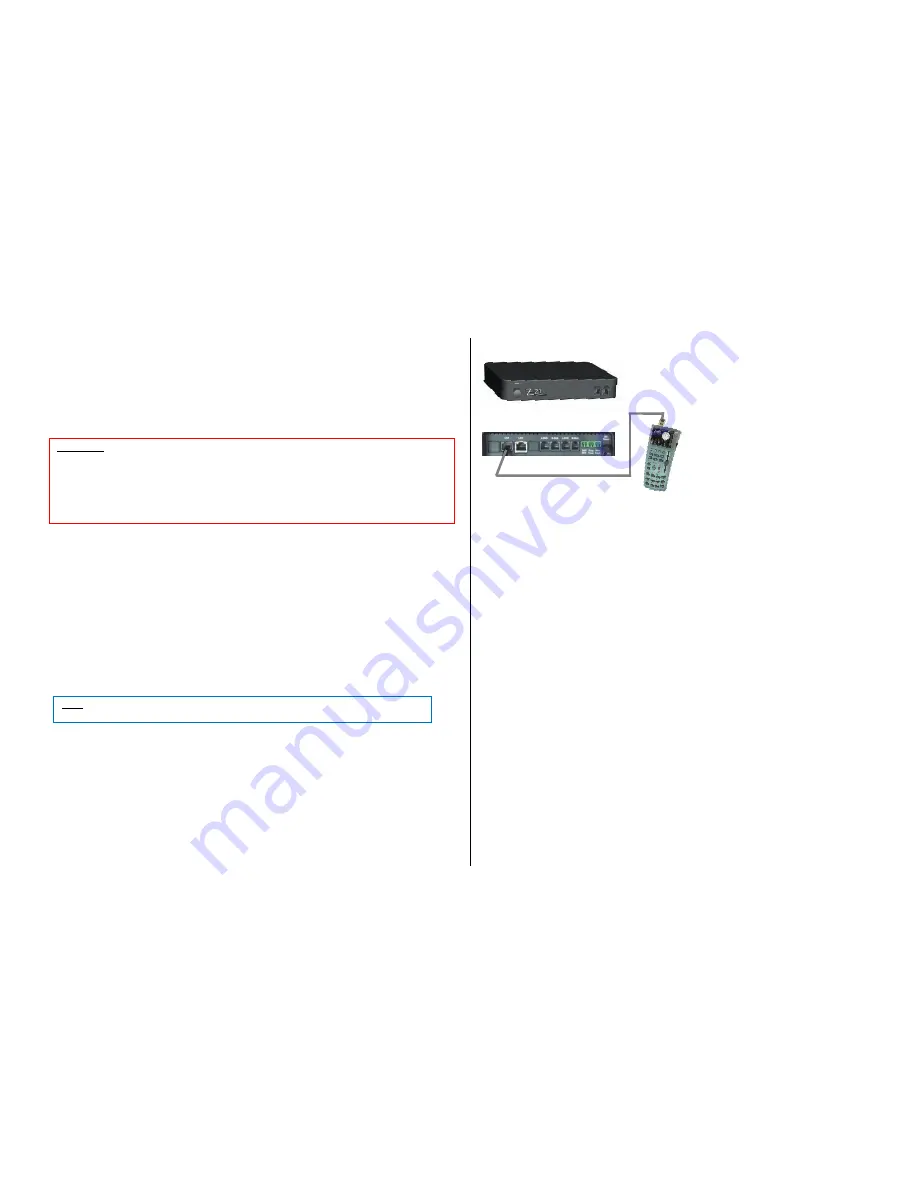
TETHERED CONTROLLER MX32, RADIO CONTROLLER MX32FU Page 5
A maximum of
3
ZIMO MX32 controllers or 1
MX32FU
*)
radio controller can be connected to a
Roco Z21 command station
using a 6-conductor
CAN cable.
*)
The radio controller can only be operated tethered be-
cause the Z21 is not equipped with a radio module. Also,
due to the larger batteries in the MX32FU, more power may
be required from the Z21 compared to a non-radio controller.
This limitation is caused by the available power of the
Z21; feeding power from an external power supply to
the CAN bus cable (min. 12 V, about 200 mA per
controller) eliminates this short coming.
The current consumption of the MX32 and MX32FU
is also higher during a software update via flash
drive, and therefore connecting one controller should
be the limit.
NOTE: Combining the "old command station" MX1 with MX32: the data for the function keys higher than
F8 has a low priority
in the CAN transmission cycle, which can therefore lead to delays.
Notes to CAN bus wiring:
The MX32 and MX32FU (as well as all previous types from MX2 to MX31) have two identical CAN bus
sockets, which are wired internally in parallel.
These sockets accept
6-pin plug CAN bus cables
, coming directly from the command station MX10,
but can also be connected to an empty socket of a StEin module. The cable contains the power supply
AS WELL AS the communication wires, and thereby connects all controllers in the system in parallel;
usually by connecting the first controller to the command station (MX1...MX10), from the first controller
to the second controller and so on.
The CAN bus is designed to be part of a linear network, using a cable with a defined wave impedance
and each with a terminating resistor at both ends, which would allow for a cable length of up to 1km.
However, in practice different topologies of tree, star and linear structures are often mixed and can lead
to losses. To ensure optimum data transmission and speed, such extreme cable lengths are not
recommended.
There are absolutely
no restrictions
with a
total cable length of up to 30 yd.
(the sum of all 6-pin or
8-pin CAN bus cables); branches can be freely incorporated; this cable length can be extended if one or
more termination resistor are used.
However, the CAN bus can also operate at higher bit-rates when needed, up to 1 Mbit / sec (instead of
the 125 Kbit / sec in normal mode). If this is the case (i.e. for image or audio file transfer), and the CAN
bus network exceeds the maximum length by a few yards, stricter wiring guidelines must be adhered to.
Please note that the total cable length is also important due to the current supply to the controllers: as a
rule of thumb, there should be no more than 2 controllers at the end of a 50 yard cable, no more than 5
controllers at the end of a 20 yard cable and so on.
Notes regarding radio operation:
Before a radio controller MX32FU can communicate with a command station MX10 via radio, it must
“register itself” with the system. This happens when the radio controller is connected once with a CAN
bus cable to the running MX10. On this occasion a logical connection is made by transferring a system
code, which is permanently retained until a new cable connection is established with another MX10. Al-
so see chapter “The Special Features In Radio Mode”.
The radio range can be improved by changing the supplied standard antennas (on the command station
MX10 and the MX32FU) against antennas with higher gain. However, this is only practical for the com-
mand station since it is usually placed at a fixed location, whereby the radiating characteristics of the
antenna can be optimally utilized and the extra length of the antenna is not an issue. Using a "large" an-
tenna at the MX10 and "small" antennas on the MX32FUs is permitted!
Connecting a MX32 to a ROCO Z21 command station:
There are hardly any functional limits with the MX32 when connected to a Z21 command station. However,
reading and writing CVs (in OP PROG or SERV PREOG) is currently not transmitted via the CAN bus.
ATTENTION:
The “CAN bus“ is not just used by ZIMO, but meanwhile also by other DCC manufacturers; the CAN
bus of the
Roco command station “Z21”,
for example, is in fact compatible and therefore suitable to connect a
MX32 cab. Otherwise they are independent and incompatible CAN bus implementations.
CAN bus cables
6-conductor and 8-conductor (
6POLxM, 8POLxM
as well as
CAN bus adapter cables
8POLAxM
(from 8
– 6-pin)) can be ordered in standard and custom length from ZIMO (see Product- and Pricelist).
The 6-pin CAN bus cables can also be homemade, the required material (6-conductor flat cable, plugs (50 per
package)) and assembly pliers are also available from ZIMO. 8-pin CAN bus cables are exactly the same as
conventional ethernet cables, which can therefore be used as well.






































